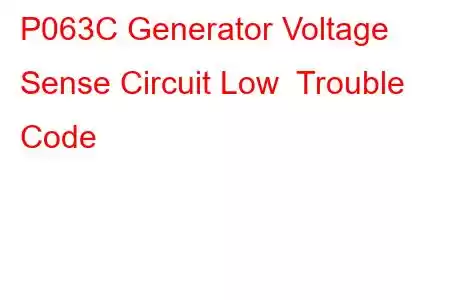P063C Generator Voltage Sense Circuit Low
OBD-II Trouble Code Technical Description
Generator Voltage Sense Circuit Low
What does that mean?
This is a generic diagnostic trouble code (DTC) and applies to many OBD-II vehicles (1996-newer). That may include but is not limited to vehicles from Jeep, Chrysler, Dodge, Ram, Cummins, Land Rover, Mazda, etc. Although generic, the exact repair steps may vary depending on year, make, model and powertrain configuration.
The P063C OBDII trouble code is associated with the generator voltage sense circuit. When the Powertrain Control Module (PCM) detects improper signals within the generator voltage sense circuit code P063C will be set. Based on the vehicle and the specific malfunction the battery warning light, check engine light or both will be illuminated. Related codes associated with this circuit are P063A, P063B , P063C, and P063D.
The purpose of the generator voltage sense circuit is to monitor the alternator and battery voltage during vehicle operation. The output voltage of alternator must be at a level that is capable of compensating for battery draws from electrical components including the starter, lighting and various other accessories. In addition, the voltage regulator must adjust the output to provide sufficient voltage to charge the battery.
Code P063C is set by the PCM when it detects a low voltage situation within the generator (alternator) sense circuit.
Example of an alternator (generator):
What is the severity of this DTC?
The severity of this code can vary tremendously from just an illuminated check engine light or battery warning light on a vehicle that starts and runs to an automobile that will not start at all.
What are some of the symptoms of the code?
Symptoms of a P063C trouble code may include:
Battery warning lamp illuminated The engine will not start The engine will crank over slower than normal Check engine light illuminatedWhat are some of the common causes of the code?
Causes for this P063C code may include:
Faulty alternator Defective voltage regulator Loose or damaged serpentine belt Defective serpentine belt tensioner Blown fuse or fuse-able link (if applicable) Corroded or damaged connector Corroded or damaged battery cable Faulty or damaged wiring Faulty PCM Defective batteryWhat are some P063C troubleshooting steps?
The first step in the troubleshooting process for any malfunction is to research the Technical Service Bulletins (TSB's) for the specific vehicle by year, model and power plant. In some circumstances this can save a lot of time in the long run by pointing you in the right direction.
The second step is a thorough visual inspection to check the associated wiring for obvious defects such as scraping, rubbing, bare wires, or burn spots. Next is to check the connectors and connections for security, corrosion and damaged pins. This process must include all wiring connectors and connections to the battery, alternator, PCM, and the voltage regulator. Some charging system configurations may be more complex including relays, fuse-able links and fuses in some circumstances. The visual inspection should also include the condition of the serpentine belt and the belt tensioner. The belt should be tight with a sight amount of flexibility and the tensioner must move freely and apply the appropriate amount of pressure on the serpentine belt. Based on the vehicle and the charging system configuration a defective or damaged voltage regulator will require an alternator replacement in most circumstances.
Advanced Steps
The advanced steps become very vehicle specific and require the appropriate advanced equipment to perform accurately. These procedures require a digital multi meter and the specific technical references for the vehicle. The ideal tool to use in this situation is a
Read: 44


